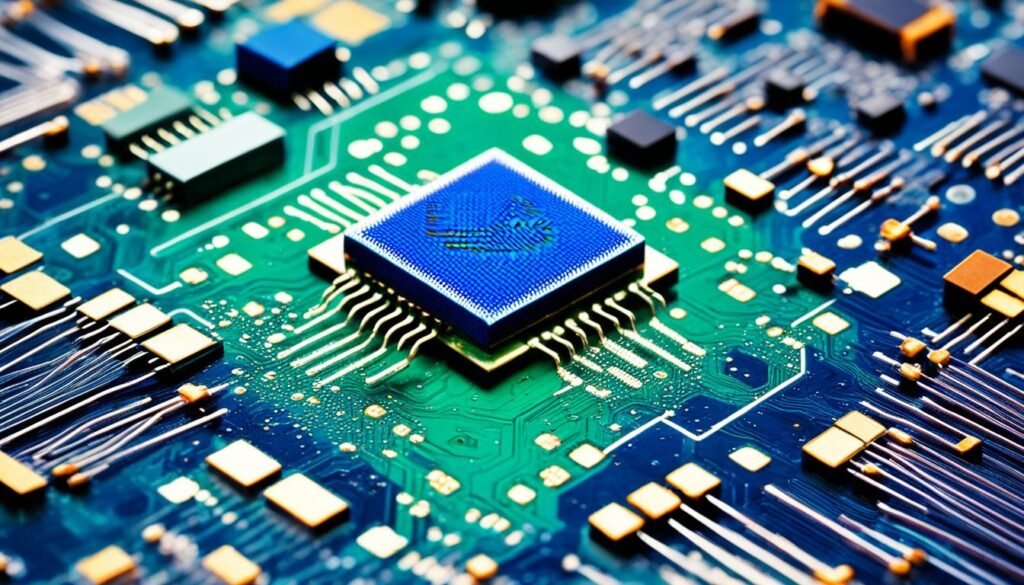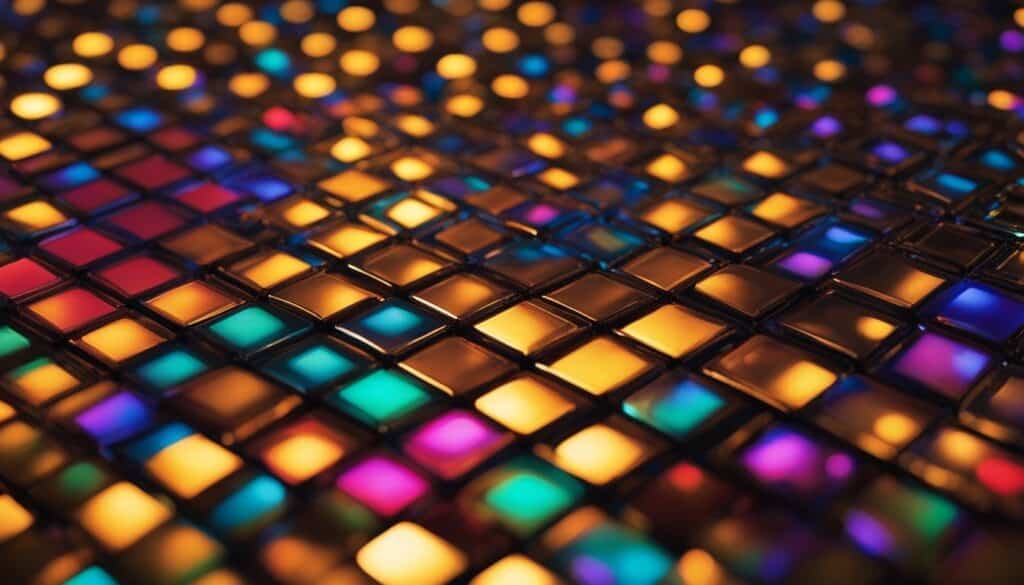Nanotechnology helps make electronic devices smaller yet more powerful. It does this by working at the atomic and molecular levels. This makes electronics better, lighter, and more energy-efficient.
It’s set to boost energy efficiency, health, and environmental care. Nanotechnology cuts costs and resources in making products. So, expect devices to become cheaper, lighter, and more sustainable.
Nanotechnology deals with stuff at a super tiny scale, using atoms and molecules. A nanometer is one billionth of a meter, or ten times a hydrogen atom’s diameter. It created a field called nanobiotechnology, which is all about making things tiny from living stuff.
It also merged with electronics to form nanoelectronics. This field works on very small electronic devices. So, it’s fascinating how tiny tech can get!
Key Takeaways
- Nanotechnology lets us work with materials at extreme smallness to make electronics better.
- This tech can make devices perform better, shrink in size, and use less power.
- Nanoelectronics focuses on creating electronics on a super small scale.
- Nanobiotechnology works with tiny bits of life to create advanced health solutions.
- Thanks to nanotechnology, products will get smaller, cheaper, and better for the earth.
Introduction to Nanotechnology in Electronics
Nanotechnology is a field that makes tiny, powerful things. It works on the size of individual atoms and molecules. A nanometer is a billionth of a meter, or about ten times the size of a hydrogen atom. This field lets us change materials at their smallest level to make them work better in electronics.
Definition of Nanotechnology
Nanotechnology deals with materials and devices that are really small, between 1 and 100 nanometers. At this tiny size, things start acting differently. The special characteristics of materials like unique chemical and physical traits come out. This is thanks to physical effects and quantum mechanical properties.
Also Read: Top Universities in America – A Definitive Guide
Nanoscale Measurements
Measuring things at the nanoscale is key in nanotechnology. Despite being made of the same stuff, materials at the nanoscale act differently than bigger versions. We use special tools like atomic force microscopy and scanning tunneling microscopy. These let us see and touch materials at the tiniest level.
Importance of Nanotechnology in Electronics
Nanotechnology is key for better electronics in many ways. It can make devices work better, needing less energy. This means smaller, cheaper, and greener devices. It can also help in healthcare and make manufacturing more efficient and cheaper.
Nanoelectronics

Nanoelectronics combines nanotechnology with electronics. It focuses on creating and studying tiny electronic devices. When materials are made smaller, their electronic behavior changes. This is because tiny particles start to behave differently.
Also Read: How Does Biotechnology Help In Environmental Conservation?
Nanotransistors
Transistors on a nanoscale are known as nanotransistors. They’re vital in nanoelectronics. Nanotransistors use the special features of nanomaterials. This makes electronic devices faster, better, and use less power.
Nanowires and Nanotubes
Nanowires and nanotubes are really tiny materials. They’re important in nanoelectronics too. These materials are great for making electronic parts. They do this because of their excellent electrical and physical properties.
Quantum Dots
Then, there are quantum dots. They’re tiny, semiconducting crystals. They stand out because of their special optical and electronic properties. Quantum dots are used in things like better displays and solar cells.
Also Read: Easy Ways To Manage Your Money For A Better Future
Nanotechnology in Semiconductor Manufacturing
![]()
Nanotechnology is key in making smaller electronics through atomic layer deposition (ALD). This method helps by adding very thin layers of materials at the smallest scale. Thus, electronic gadgets advance in performance and features.
Atomic Layer Deposition
Atomic layer deposition (ALD) adds materials with atomic-scale accuracy. It uses gases precisely to grow films layer by layer. This ensures even films on very complex structures. With this precise technique, we can control and improve the materials in our gadgets.
Also Read: How Does GPS Navigation Work on Phones?
Extreme Ultraviolet Lithography
For even smaller features on chips, the industry uses extreme ultraviolet (EUV) lithography. This method uses very short wavelength light for more details and circuits. Nanotechnology supports EUV lithography, making it possible to build even smaller, powerful gadgets.
Nanotechnology in Memory Devices

Nanotechnology allows us to create high-tech memory devices by playing with smaller-than-atom materials. It has brought us two key memory technologies: nanocrystal and molecular memory.
Nanocrystal Memory
Nanocrystal memory uses tiny nanocrystals in a special layer to save data. This method packs more data in a smaller space and keeps it better than usual flash memory. The tiny size of the crystals makes storing data more efficient, making memories work better while using less power.
Also Read: Securing Tomorrow: How To Build An Emergency Fund That Saves The Day
Molecular Memory
In molecular memory, single molecules are used to keep our data safe. This new tech is exciting because it can hold even more data and find it quicker than nanocrystal memory. It’s a big step forward in making memories bigger and faster.
These new memory techno>logiet;sshow how nanotechnology is changing electronics. We’re seeing more memory, less power use, and better performance in our gadgets than ever before.
Nanotechnology in Display Technologies
Nanotechnology has changed the display world. It has brought new solutions in image quality, saving energy, and size. Examples like quantum dot displays and carbon nanotube field emission displays show how powerful nanotech can be.
Quantum Dot Displays
Quantum dot displays are small, light-emitting crystals. They can show a wide range of colors and save more energy. Manufacturers use the size and mix of these crystals to make colors in displays pop. Now, our TVs and phones have super colorful, realistic images thanks to this technology.
Carbon Nanotube Field Emission Displays
Carbon nanotube field emission displays are also game-changers. They’re made with carbon nanotubes, which are thin and save energy. These nanotubes are great at conducting electricity and are very tiny. This makes the displays they’re in thinner and use less power. They’re leading us into a new era of sharp, flexible, and efficient displays.
Also Read: 7 Latest Technology Trends Around the World
Nanotechnology in Energy Storage
Nanotechnology is changing how we store energy. It’s helping meet our need for efficient energy systems. Specifically, it’s making big strides in lithium-ion batteries, supercapacitors, and fuel cells.
Lithium-Ion Batteries
Lithium-ion batteries power our electronics, from phones to cars. Nanotechnology has upgraded these batteries by adding tiny materials like nanoparticles. These materials boost energy storage, charge faster, and are safer. For example, batteries now use silicon nanowires to store more lithium. And special cathode materials make the battery work better.
Supercapacitors
Supercapacitors are a fast-growing way to store energy. They use nanomaterials like carbon nanotubes and graphene. These materials have a lot of surface area and move electricity well. This helps supercapacitors charge quickly. They’re great for electric cars and green energy systems.
Fuel Cells
Nanotechnology is also big in fuel cells. These devices turn chemicals into electricity. By using tiny materials like platinum particles, fuel cell efficiency has gone up. This means more power and less cost. Plus, new membranes and electrodes assist in energy flow, making fuel cells even better at their job.
FAQs
Q: What is nanotechnology and how is it related to electronics?
A: Nanotechnology deals with materials at the nanoscale level, which is extremely small, typically between 1 to 100 nanometers. In electronics, nanotechnology is used to manipulate and control materials at the atomic and molecular level to create smaller, faster, and more efficient electronic devices.
Q: What are nanomaterials and how are they used in electronics?
A: Nanomaterials are materials with dimensions at the nanoscale. In electronics, nanomaterials such as nanostructures, oxides, and nanocomposites are used to enhance the performance of electronic components by improving conductivity, increasing durability, and reducing size.
Q: What are some common applications of nanotechnology in electronics?
A: Nanotechnology is used in electronics for various applications such as developing nanoelectronics, nanocoatings, nanomedicine for drug delivery, and enhancing the properties of materials like zinc oxide and titanium dioxide.
Q: What are the benefits of using nanotechnology in electronics?
A: Nanotechnology offers benefits such as improving the efficiency and performance of electronic devices, reducing energy consumption, increasing storage capacity, and enabling the development of innovative consumer products.
Q: What is the role of nanoscience and nanotechnology in the field of electronics?
A: Nanoscience and nanotechnology play a crucial role in advancing the field of electronics by enabling the design and fabrication of electronic devices at the nanoscale, leading to new breakthroughs in materials science, conductivity, and biomedical applications.
Q: How is nanotechnology contributing to advancements in tissue engineering and human health?
A: Nanotechnology is used in tissue engineering to create scaffolds at the nanoscale that mimic the natural extracellular matrix, promoting tissue regeneration and enhancing biomedical applications for human health, such as targeted drug delivery and diagnostics.
Q: What is the National Nanotechnology Initiative and its impact on the development of nanotechnology applications?
A: The National Nanotechnology Initiative is a federal research and development program in the United States that coordinates nanotechnology-related activities across various government agencies to advance nanotechnology research, development, and commercialization for the benefit of society and the economy.
Source Links
- https://www.knowledgenile.com/blogs/how-can-nanotechnology-be-useful-in-electronic-devices
- https://pubmed.ncbi.nlm.nih.gov/33494686/
- https://www.ipc.org/system/files/technical_resource/E17&S11-1.pdf




